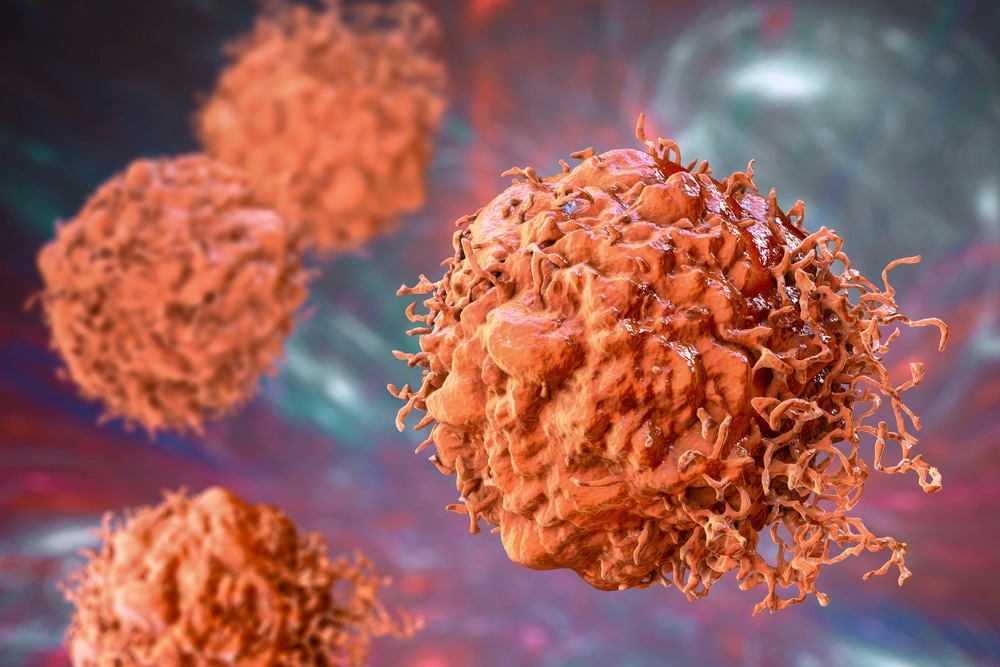Although chemodynamic therapy (CDT)-triggered apoptosis is a potential anticancer treatment, its clinical translation is impeded due to the low efficacy and side effects. An article published in the journal Acta Biomaterialia, demonstrated the fabrication of surface-engineered ginsenoside Rg3-sheltered nanocatalysts with improved organ distribution, low toxicity, and increased in vivo efficacy.

Study: Dynamic ginsenoside-sheltered nanocatalysts for safe ferroptosis-apoptosis combined therapy. Image Credit: Kateryna Kon/Shutterstock.com
Rg3-sheltered nanocatalysts formed hydrophilic nanoclusters, which helped prolong their circulation in the bloodstream, increasing their accumulation at the tumor site. The hydrophilic nanoclusters of nanocatalysts provided a drug-loading platform for Rg3 to increase its bioavailability and achieve a synergistic effect.
Rg3-sheltered nanocatalysts simultaneously activated apoptosis and ferroptosis to improve anticancer efficacy. Furthermore, the administration of Rg3-sheltered nanocatalysts suppressed 86.6% of tumor growth toxicity and increased the survival time of mice. The present work addressed the biosafety problems associated with nanomedicine and provided new insight into catalytic ferroptosis-apoptosis conjunct antitumor therapies.
Nanocatalysts in Anticancer Treatment
Recent developments in nanotechnology have enabled researchers to study confinement effects in nanocatalysts, including changes in the physical, electronic, and photonic properties. Due to the unique size, shapes, and properties of nanomaterials, scientists have designed many nanocatalysts with wide-ranging functions.
Nanocatalysts stand at the boundary between heterogeneous and homogeneous catalysts in the sense that, in many cases, they offer advantages from both in terms of activity, selectivity, efficiency, and re-usability. The development of nanocatalysts promoted their integration into biomedicine leading to an advanced treatment strategy termed nanocatalytic therapy, which includes CDT, photodynamic therapy, sonodynamic, and electrodynamic therapies.
Particularly, CDT is used as an anticancer treatment that is based on catalytic Fenton reaction and without the need for an externally applied field. CDT serves as a catalyst used to convert hydrogen peroxide (H2O2) and iron ions into reactive oxygen species (ROS) via Fenton reactions. The formed ROS penetrates the nucleus through nuclear pores and causes cell apoptosis. Thus, the in vivo therapeutic effects depend on the Fenton reaction.
Ferroptosis is non-apoptotic regulated cell death. It is morphologically, biochemically, and genetically distinct from other well-known forms of cell death, including apoptosis, various forms of necrosis, and autophagy. Ferroptosis is a distinct regulated cell death process driven by accumulated iron-dependent lipid ROS. The lethal metabolic imbalance resulting from glutathione depletion or inactivation of glutathione peroxidase 4 is the executor of ferroptosis within the cancer cell.
Rg3-Sheltered Nanocatalysts for Safe Ferroptosis-Apoptosis Therapy
The ferroptosis-apoptosis combined therapy is a potential strategy to inhibit tumor growth that requires a multifunctional metal that can reach the tumor site and promote the catalytic effects of H2O2 and ferroptosis activators.
Moreover, it is also critical to protect the ferrous (Fe2+) ion from oxidative stress due to its high reaction efficiency compared to its ferric (Fe3+) ion counterpart. Thus, achieving these goals can combat the toxicity problems associated with Fenton-type heavy metals in CDT.
Despite the advantages of Rg3 in anticancer treatment and in preventing liver injury, they have extremely low bioavailability and can get easily metabolized by kidneys. Thus, a very small amount of Rg3 reaches the tumor site, lowering its efficacy.
The present work aimed to overcome the above challenges by synthesizing a multilayered nano-iron platinum (FePt)-Rg3 (NFPR) with hierarchical microstructures using (FePt)@(Fe1−xPtx)Oy(OH)z hybrid nanoparticles coupled with Rg3, ultimately forming Rg3-sheltered dynamic nanocatalysts.
Surface functionalization of nanoparticles with Rg3 altered the pharmacokinetic properties of resulting nanocatalysts and extended their circulation time in the bloodstream. The improved pharmacokinetics increased the accumulation of Rg3-sheltered nanocatalysts in tumors on being systematically administered in a pancreatic tumor mouse model.
The accumulation of the synthesized nanocatalysts was disassembled in the tumor microenvironment (TME) due to the susceptibility of NFPR in acidic TME. Thus, the present strategy addressed the premature leakage of metal ions before reaching the target site, which is typically not observed in conventional CDT.
In addition, the advantage of the hydrophilic cluster group formed by the nanocatalysts transports more Rg3 to the tumor site, thus, overcoming the limitation of low bioavailability found in pure Rg3. The Fe2+ and Fe3+ ions present on the fabricated nanodrug stimulated apoptosis and ferroptosis. Thus, the present study offered Rg3-functionalized dynamic nanocatalysts as an effective and safe anticancer therapy.
Conclusion
To summarize, Rg3-sheltered nanocatalysts served as a transformable ferrous ion for ferroptosis-apoptosis combined anticancer therapy. The NFPR altered the pharmacokinetics and organ distribution of nanocatalysts and avoided the liver damage caused by nanoparticles, addressing the biosafety concerns of nanomedicines.
The high stability in the physiological environment and hydrophilic surface of NFPR enabled its extended circulation in the bloodstream. Moreover, the NFPR escaped from the degradation by endogenous factors well before the ferroptosis activator reached the tumor, activating the ferroptosis and apoptosis of cancer cells.
The administration of Rg3-sheltered nanocatalysts suppressed the growth of pancreatic tumors without causing toxic effects on healthy cells. Thus, the present work offered a new strategy for developing ferroptosis-apoptosis synergic anticancer therapy for cancer treatment.
Reference
Zhao, X. et al. (2022) Dynamic Ginsenoside-Sheltered Nanocatalysts for Safe Ferroptosis-Apoptosis Combined Therapy. Acta Biomaterialia. https://www.sciencedirect.com/science/article/pii/S1742706122005037?via%3Dihub
Disclaimer: The views expressed here are those of the author expressed in their private capacity and do not necessarily represent the views of AZoM.com Limited T/A AZoNetwork the owner and operator of this website. This disclaimer forms part of the Terms and conditions of use of this website.